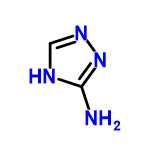Amitrole C2H4N4 structure – Flashcards
Flashcard maker : Lewis Gardner
Contents
- Experimental Melting Point:
- Experimental Vapor Pressure:
- Experimental LogP:
- Experimental Gravity:
- Predicted Melting Point:
- Appearance:
- Stability:
- Toxicity:
- Safety:
- First-Aid:
- Exposure Routes:
- Symptoms:
- Target Organs:
- Incompatibility:
- Personal Protection:
- Exposure Limits:
- Therapeutical Effect:
- Drug Status:
- Compound Source:
- Retention Index (Kovats):

| Molecular Formula | C2H4N4 |
| Average mass | 84.080 Da |
| Density | 1.5±0.1 g/cm3 |
| Boiling Point | 347.2±25.0 °C at 760 mmHg |
| Flash Point | 190.7±10.4 °C |
| Molar Refractivity | 21.1±0.3 cm3 |
| Polarizability | 8.4±0.5 10-24cm3 |
| Surface Tension | 105.5±3.0 dyne/cm |
| Molar Volume | 56.5±3.0 cm3 |
- Experimental data
- Predicted – ACD/Labs
- Predicted – EPISuite
- Predicted – ChemAxon
- Predicted – Mcule
- Experimental Physico-chemical Properties
- Predicted Physico-chemical Properties
- Miscellaneous
- Gas Chromatography
Predicted data is generated using the ACD/Labs Percepta Platform – PhysChem Module
| Density: | 1.5±0.1 g/cm3 |
| Boiling Point: | 347.2±25.0 °C at 760 mmHg |
| Vapour Pressure: | 0.0±0.8 mmHg at 25°C |
| Enthalpy of Vaporization: | 59.2±3.0 kJ/mol |
| Flash Point: | 190.7±10.4 °C |
| Index of Refraction: | 1.670 |
| Molar Refractivity: | 21.1±0.3 cm3 |
| #H bond acceptors: | 4 |
| #H bond donors: | 3 |
| #Freely Rotating Bonds: | 0 |
| #Rule of 5 Violations: | 0 |
| ACD/LogP: | -1.25 |
| ACD/LogD (pH 5.5): | -1.12 |
| ACD/BCF (pH 5.5): | 1.00 |
| ACD/KOC (pH 5.5): | 5.59 |
| ACD/LogD (pH 7.4): | -1.07 |
| ACD/BCF (pH 7.4): | 1.00 |
| ACD/KOC (pH 7.4): | 6.20 |
| Polar Surface Area: | 68 Å2 |
| Polarizability: | 8.4±0.5 10-24cm3 |
| Surface Tension: | 105.5±3.0 dyne/cm |
| Molar Volume: | 56.5±3.0 cm3 |
Predicted data is generated using the US Environmental Protection Agency’s EPISuite™
Log Octanol-Water Partition Coef (SRC): Log Kow (KOWWIN v1.67 estimate) = -0.47 Log Kow (Exper. database match) = -0.86 Exper. Ref: Sangster (1994) Boiling Pt, Melting Pt, Vapor Pressure Estimations (MPBPWIN v1.42): Boiling Pt (deg C): 258.30 (Adapted Stein & Brown method) Melting Pt (deg C): 69.52 (Mean or Weighted MP) VP(mm Hg,25 deg C): 0.000735 (Modified Grain method) MP (exp database): 159 deg C VP (exp database): 4.40E-07 mm Hg at 25 deg C Subcooled liquid VP: 9.31E-006 mm Hg (25 deg C, exp database VP ) Water Solubility Estimate from Log Kow (WSKOW v1.41): Water Solubility at 25 deg C (mg/L): 6.967e+005 log Kow used: -0.86 (expkow database) no-melting pt equation used Water Sol (Exper. database match) = 2.8e+005 mg/L (25 deg C) Exper. Ref: MARTIN,H & WORTHING,CR (1977) Water Sol Estimate from Fragments: Wat Sol (v1.01 est) = 1e+006 mg/L Wat Sol (Exper. database match) = 280000.00 Exper. Ref: MARTIN,H & WORTHING,CR (1977) ECOSAR Class Program (ECOSAR v0.99h): Class(es) found: Aromatic Amines Henrys Law Constant (25 deg C) [HENRYWIN v3.10]: Bond Method : 5.40E-010 atm-m3/mole Group Method: Incomplete Exper Database: 2.21E-13 atm-m3/mole Henrys LC [VP/WSol estimate using EPI values]: 1.167E-010 atm-m3/mole Log Octanol-Air Partition Coefficient (25 deg C) [KOAWIN v1.10]: Log Kow used: -0.86 (exp database) Log Kaw used: -11.044 (exp database) Log Koa (KOAWIN v1.10 estimate): 10.184 Log Koa (experimental database): None Probability of Rapid Biodegradation (BIOWIN v4.10): Biowin1 (Linear Model) : 0.4738 Biowin2 (Non-Linear Model) : 0.4770 Expert Survey Biodegradation Results: Biowin3 (Ultimate Survey Model): 2.8784 (weeks ) Biowin4 (Primary Survey Model) : 3.6180 (days-weeks ) MITI Biodegradation Probability: Biowin5 (MITI Linear Model) : 0.3125 Biowin6 (MITI Non-Linear Model): 0.2674 Anaerobic Biodegradation Probability: Biowin7 (Anaerobic Linear Model): 0.4628 Ready Biodegradability Prediction: NO Hydrocarbon Biodegradation (BioHCwin v1.01): Structure incompatible with current estimation method! Sorption to aerosols (25 Dec C)[AEROWIN v1.00]: Vapor pressure (liquid/subcooled): 0.00124 Pa (9.31E-006 mm Hg) Log Koa (Koawin est ): 10.184 Kp (particle/gas partition coef. (m3/ug)): Mackay model : 0.00242 Octanol/air (Koa) model: 0.00375 Fraction sorbed to airborne particulates (phi): Junge-Pankow model : 0.0803 Mackay model : 0.162 Octanol/air (Koa) model: 0.231 Atmospheric Oxidation (25 deg C) [AopWin v1.92]: Hydroxyl Radicals Reaction: OVERALL OH Rate Constant = 5.5208 E-12 cm3/molecule-sec Half-Life = 1.937 Days (12-hr day; 1.5E6 OH/cm3) Half-Life = 23.249 Hrs Ozone Reaction: No Ozone Reaction Estimation Fraction sorbed to airborne particulates (phi): 0.121 (Junge,Mackay) Note: the sorbed fraction may be resistant to atmospheric oxidation Soil Adsorption Coefficient (PCKOCWIN v1.66): Koc : 24.28 Log Koc: 1.385 Aqueous Base/Acid-Catalyzed Hydrolysis (25 deg C) [HYDROWIN v1.67]: Rate constants can NOT be estimated for this structure! Bioaccumulation Estimates from Log Kow (BCFWIN v2.17): Log BCF from regression-based method = 0.500 (BCF = 3.162) log Kow used: -0.86 (expkow database) Volatilization from Water: Henry LC: 2.21E-013 atm-m3/mole (Henry experimental database) Half-Life from Model River: 2.429E+009 hours (1.012E+008 days) Half-Life from Model Lake : 2.65E+010 hours (1.104E+009 days) Removal In Wastewater Treatment: Total removal: 1.85 percent Total biodegradation: 0.09 percent Total sludge adsorption: 1.76 percent Total to Air: 0.00 percent (using 10000 hr Bio P,A,S) Level III Fugacity Model: Mass Amount Half-Life Emissions (percent) (hr) (kg/hr) Air 5.21e-006 46.5 1000 Water 38.9 360 1000 Soil 61 720 1000 Sediment 0.0713 3.24e+003 0 Persistence Time: 579 hr
Click to predict properties on the Chemicalize site
- 1-Click Docking
- 1-Click Scaffold Hop


